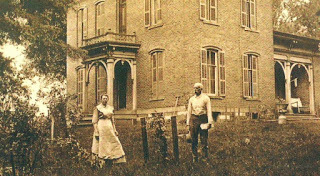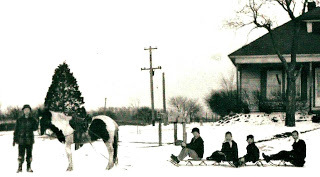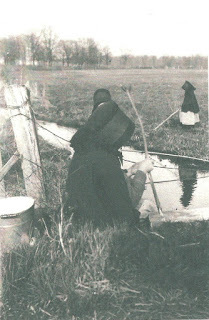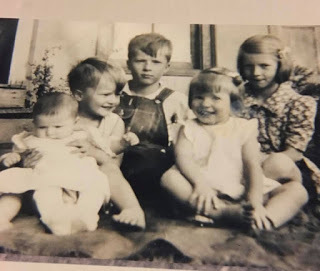Mining Your Family Tree for Story Ideas

by Jan Drexler
We tend to think our families are nice, normal, boring people, right?Oh, sure, there’s Aunt Hattie, who was rumored to have been a flapper back in the 1920’s. Or Uncle Jack, who left home when he was fourteen and didn’t write to the folks he left behind for twenty years, after he had become a successful cattle rancher in Colorado.But other than that…

From my very first book, I have delved into the roots of my family’s past to find characters and story ideas. One part of my family has solid Amish roots dating back to the Reformation, and that branch gives me some great fodder for my Amish stories.Another branch is a bunch of ne’er-do-wells who ranged from murderers and thieves to river rats living along the banks of the Ohio River. I haven't started writing about that side of the family. Yet.In this post, I hope to give you some ideas of how you can

Start with the FactsThe first place to start is with your genealogy. I use Ancestry.com, but there are other websites to help you search for your ancestors. Almost every library has a genealogy room, and they are often staffed with people to help you get started. Or perhaps one of your relatives has already started a genealogy study - ask!Old photo albums are another great place to start. Hopefully, someone identified who is in the pictures!

Once you plug in your grandparents’ names and where they were born, a whole new world starts opening. A simple family tree grows branches as you find the names of your great-grandparent’s siblings and their descendants, and when you dig deeper, you find details that you might have skimmed over if you weren’t looking for stories.For instance, you might find that your great-uncle had a wife who died in Ireland before he emigrated to America, and that he left three children behind. Or you might find that the person you knew as “Great-Grandma” was actually your grandfather’s foster mother, who had only stepped in to take care of the children when your great-grandparents disappeared in a snow storm…It's easy to get caught up in the "what-if's!"

Fill in the Missing PiecesThrough studying your genealogy, you can find out when your ancestors came to America. Further searching can reveal the ship’s manifest, listing the other passengers. Census records will tell you where you ancestors lived, who lived with them, and who their neighbors were.And that’s just the tip of the iceberg!
Once you have your details – even only a few – you can let your imagination and story-building skills go to work. And remember: You’re writing fiction, not biography. Anything goes.

Expand the Playing FieldWhen you have your story nugget, you start expanding your knowledge of the time period and setting.Let me use an example from my own research. While working on my husband’s genealogy, I found that his great-grandfather emigrated to America from Germany in 1880, accompanied by his wife and two adult children, Barbara and Caspar…and a nine-month-old girl named Maria. Further searching revealed the name of the woman who would eventually become Caspar’s wife, who was traveling alone on the same ship.Those are the bare-bones facts, but do you see the story fodder in these details?Less than three months later, Barbara married a man twice her age who was living in Toledo. Augustus had emigrated five years earlier from the same town in Germany as Barbara’s family, so they must have known each other back then. The story’s details keep growing, don’t they?And what happened to Maria? After Barbara’s mother passed away a few years later, Augustus moved his family – including a five-year-old Maria – to a Nebraska homestead just south of Lincoln.

When I finally write this piece of family history into a story or series, I’ll research homesteading in Nebraska, ocean crossings in 1880, what the immigration experience was before Ellis Island, overland travel from New York to Toledo, and then to Nebraska.I’ll use some of my favorite resources. One is Historic Mapworks, where you can search maps from around the world for almost any time period. I have already been able to find Augustus and Barbara’s homestead using this resource.I also use Google Maps extensively. Even though the maps are contemporary, you can still learn a lot about a place through their street view and 3-D features. After I get a sense of “place” through the maps, I start looking for source materials for research. I use internet search engines to start looking for books written about my subject. For this story I would search for European immigrant’s stories and homesteader’s diaries from Nebraska. I would also search for any other books written about these subjects.
Give Your Characters Life!Once I have the setting, I start forming my characters. I use what I’ve learned in my research to create their Goals, Motivations and Conflicts. People are similar in all time periods, so while I’ll want to remain true to the culture of the time period I've chosen, my characters will have the same wants and desires that we do today.When I write this book, I think Barbara will be an interesting person to learn to know. How did her experiences shape her life? And then there’s that mystery: Whose daughter was Maria? What would she have been like as a young girl?

Dig Deep into Your RootsDon’t tell me your family is full of boring people!Think about why we write - it’s because we’re interested in people. We listen when they tell their own stories and our minds snatch the fascinating details out of the air.When you mine your family tree, you're digging for those details. Those tidbits that cause your mind to start chasing the "what-if's."Talk to your relatives. Ask them what they remember about your family. And it doesn’t have to be someone a generation or two older than you – my brother remembers stories from our family's past that I don’t, and he’s less than three years older than I am. Ask questions, then listen. What you hear just might be your next great story idea!
Have you ever mined your family tree for story ideas? Tell us about it!
One commenter will win a copy of my latest release from Love Inspired Historical, The Amish Nanny's Sweetheart. (US only please)
 Love in Plain Sight
Love in Plain Sight As nanny for her nephew, Judith Lapp’s finally part of a vibrant, joyful Amish community instead of living on the outskirts looking in. But teaching her neighbors’ Englischer farmworker to read Pennsylvania Dutch wasn’t part of her plan. And the more time she spends with Guy Hoover, the more he sparks longings for a home and family of Judith’s own.
Guy figured he would never be truly accepted by his Amish employers’ community—even though the Mast family treats him like a son. But Judith’s steadfast caring shows him that true belonging could be within his reach…if he and Judith can reconcile their very different hopes—and hearts.
Published on May 20, 2018 21:00
No comments have been added yet.



